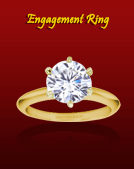Monday, February 15, 2010
Early diamond identification tests included a scratch test which relied completely on the superior hardness of diamond. Yet this test is destructive, as a diamond can scratch diamond, and is rarely used nowadays. Instead, Diamond identification can also rely on its superior thermal conductivity. Electronic thermal probes are commonly used in the gemological centers to separate diamonds from their imitations. They consist of a pair of battery-powered thermistors mounted in a fine copper tip in which one functions as a heating device while the other measures the temperature of the copper tip: if the stone being tested is a diamond, it will conduct the tip's thermal energy rapidly enough to produce a measurable temperature drop. This test takes around 2 seconds.
Whereas the thermal probe can separate diamonds from most of their simulants, distinguishing between various types of diamond irradiated or non-irradiated, etc., requires more advanced, optical techniques. These techniques are also used for some diamonds simulants, such as silicon carbide, which pass the thermal conductivity test. Optical techniques can distinguish between natural diamonds and synthetic diamonds. "Perfect" crystals have never been found, so both natural and synthetic diamonds always possess characteristic imperfections, arising from the circumstances of their crystal growth, that allow them to be distinguished from each other.
Laboratories use techniques such as spectroscopy, microscopy and luminescence under shortwave ultraviolet light to find out a diamond's origin. They also include specially made machines to aid them in the identification process. Two screening machines are the Diamond Sure and the Diamond View, both are produced by the DTC and marketed by the GIA.
Several methods for identifying the synthetic diamonds can be performed, depending on the method of production and the color of the diamond. CVD diamonds can generally be determined by an orange fluorescence. D-J colored diamonds can usually be screened through the Swiss Gemological Institutes Diamond Spotter. Similarly, natural diamonds usually have minor imperfections and flaws that are not seen in synthetic diamonds.
Whereas the thermal probe can separate diamonds from most of their simulants, distinguishing between various types of diamond irradiated or non-irradiated, etc., requires more advanced, optical techniques. These techniques are also used for some diamonds simulants, such as silicon carbide, which pass the thermal conductivity test. Optical techniques can distinguish between natural diamonds and synthetic diamonds. "Perfect" crystals have never been found, so both natural and synthetic diamonds always possess characteristic imperfections, arising from the circumstances of their crystal growth, that allow them to be distinguished from each other.
Several methods for identifying the synthetic diamonds can be performed, depending on the method of production and the color of the diamond. CVD diamonds can generally be determined by an orange fluorescence. D-J colored diamonds can usually be screened through the Swiss Gemological Institutes Diamond Spotter. Similarly, natural diamonds usually have minor imperfections and flaws that are not seen in synthetic diamonds.
Labels: Diamond Identification
posted by Tamil Nadu ,Tamilnadu Government,Places,Wild Life,Hill Stations,Temples,Sports,Accomodation,Cusine,Fine Art @ 9:41 PM
permanent link
| Post a Comment |
![]()




0 Comments:
Post a Comment
<< Home